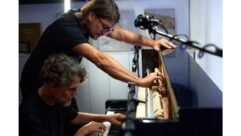Empirical or Ethereal?
Nov 1, 2001 12:00 PM,
NATHANIEL HECHT
HAVE YOU NOTICED HOW STRONG — AND DIFFERENT — OPINIONS are when it comes to the particular products in our industry? Talk to a recording engineer and you are likely to hear that acoustic guitars cannot be recorded without one specific microphone, for example. A sound touring professional might sing the praises of a particular speaker system with equal zeal.
There is subjectivity, and there is measurement. Measurement gives us some tools to compare different products. Our own perception — which involves both equipment (our ears and brain) and experience in listening — lets us judge what we are hearing subjectively. We may perceive sound differently, but we all have similar human hearing “equipment” that gives us one benchmark. When the human equipment is functioning properly, our experience as listeners seems to be the wildcard. What might be pleasing to one person is not necessarily so to the next.
While there are many elements that make up an audio system, the area of greatest subjectivity is the transducer — a microphone or speaker — where sound energy is magically transferred to electrical energy and back again.
Transducers are unique products. Although countless hours of engineering, measurement, research and development go into designing most speakers and microphones, choosing a transducer is clearly the most subjective part of the process. However, we do have fantastic modeling and measuring tools available to determine room placement of speakers in a given space, to show the effects of arraying and coupling systems, and to determine many orders of reflection in simulated spaces. We also can measure real spaces with the systems installed. There are excellent applications CDs to help with our choice of microphones whose design factors also help direct our decisions.
Then why is it often hard to choose what to use? Blame it on the brain. Hearing is so intricately wired in the brain that there is a lot of room for subjectivity. Studies have shown the effect of audio illusions on our hearing processing, and noise studies have shown the brain’s unique tolerance for distortion. (See Diana Deutsch’s article, “The Psychology of Hearing” in the December 1998 issue, page 34.) One famous study incorporated noise into different words by replacing consonants with a blast of noise to determine the perceivable result. Listeners were indeed fooled, believing that they actually heard the consonants that were removed, proving that the brain is excellent at remembering what words sound like with experience. The brain can use that experience to rebuild words from context. It seems plausible to assume that the same is also possible with music, and this phenomenon may explain why harmonic distortion is pleasing to some listeners.
The research continues, and transducers continue to transfer mechanical energy for our enjoyment. We may not unravel the mysteries of aesthetic subjectivity, but understanding the complex relationships inherent in the application of transducers will help us begin to understand the non-subjective realities and will hopefully begin to shed some light on most of the deeply held myths about these products.










